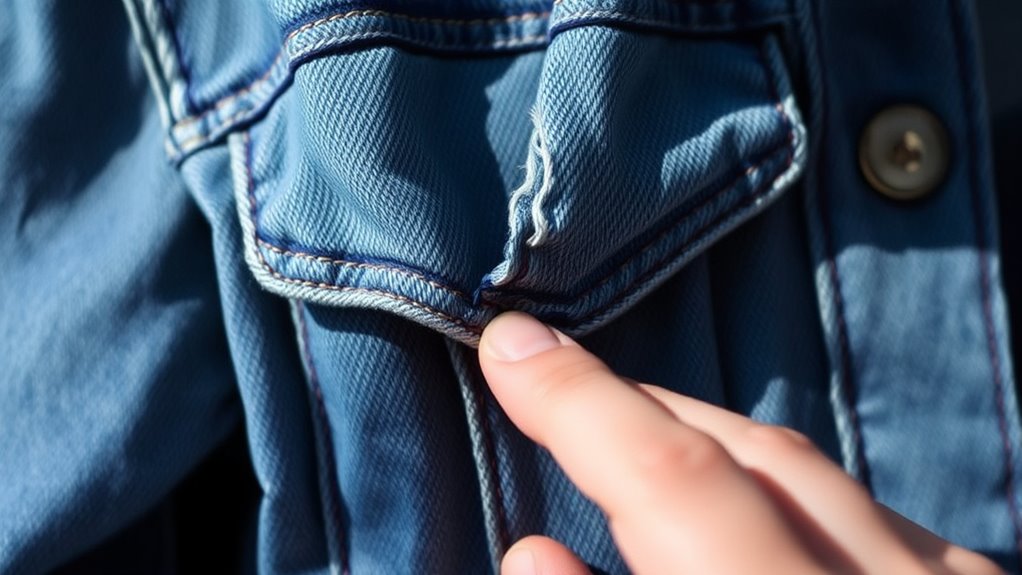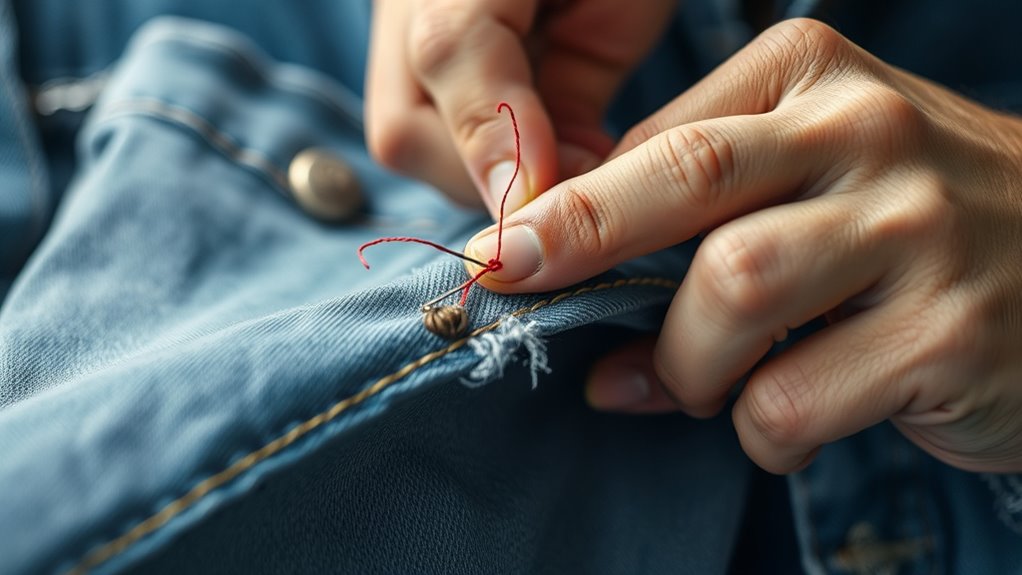By mastering five simple stitches, you can effectively repair your garments, making them last longer and reducing waste. These basic stitches, like the running stitch or backstitch, help you fix tears, replace buttons, or reinforce seams easily at home. Embracing these techniques supports a more sustainable wardrobe and cuts down on unnecessary purchases. Keep exploring repair methods to gain confidence and make your clothes truly last—there’s more you can do to extend their life.
Key Takeaways
- Basic stitches like running, backstitch, and whip stitch can effectively mend tears and reinforce worn areas.
- Sewing on a new button restores functionality and prolongs the life of shirts, coats, and trousers.
- Patching small holes or tears with fabric patches prevents further damage and extends garment wearability.
- Reinforcing seams or hems with simple stitches improves durability and prevents fraying.
- Learning these five stitches empowers DIY repairs, reducing waste and supporting sustainable fashion practices.

In a world increasingly focused on fast fashion and disposable clothing, embracing slow fashion repairs offers a meaningful way to extend the life of your garments. Instead of constantly replacing items, you can focus on fixing and maintaining what you already own. This approach not only saves money but also reduces waste, helping you make more sustainable choices. When you repair your clothes, you’re contributing to a more mindful consumption cycle. It encourages the use of sustainable textiles, which are often designed to last longer and be more environmentally friendly. These textiles might include organic cotton, hemp, or recycled fabrics, all created with a focus on durability and minimal environmental impact. Choosing garments made from such materials aligns perfectly with the principles of slow fashion and ethical manufacturing, which prioritize quality, transparency, and fair labor practices. By repairing rather than discarding, you support brands and producers who value these sustainable and ethical standards.
Getting comfortable with simple stitches and basic sewing skills empowers you to breathe new life into worn or damaged pieces. A small tear on a sleeve or a missing button can become an opportunity to practice your skills and customize your wardrobe. Repairing garments also allows you to retain sentimental pieces that hold personal value, creating a deeper connection with your clothing. Plus, it’s a much more eco-conscious choice, as it minimizes the demand for new production, which often relies on synthetic, non-biodegradable textiles and ethically questionable manufacturing practices. When you repair, you’re actively participating in a cycle that champions durability and longevity, directly challenging the throwaway culture that dominates fast fashion.
Furthermore, repair techniques can be simple or complex, depending on how much time and effort you’re willing to invest. You don’t need to be a professional seamstress to patch a hole or replace a zipper. There are countless tutorials and resources online that guide you step-by-step. As you develop your skills, you’ll find that fixing your clothes becomes a rewarding routine. It also allows you to personalize your wardrobe, giving your garments a unique touch that store-bought items often lack. By choosing to repair, you’re making a conscious decision to support a more sustainable textile industry and to promote ethical manufacturing practices, which prioritize workers’ rights and environmentally responsible processes. In the end, slow fashion repairs aren’t just about fixing clothes—they’re about making a statement and taking control of your fashion choices in a way that benefits both the planet and your personal style.
Frequently Asked Questions
What Tools Are Essential for Basic Garment Repairs?
When you’re tackling basic garment repairs, essential tools include a good sewing kit with needles, pins, and scissors. You’ll also need a sewing machine for faster stitching techniques, but don’t forget sewing machine maintenance to keep it in top shape. These tools help you mend tears, replace buttons, and extend your clothes’ life with simple stitches. With the right equipment, you can confidently handle repairs and enjoy your wardrobe longer.
How Do I Choose the Right Thread Color?
When choosing the right thread color, you want to focus on thread matching for a seamless look. If an exact match isn’t possible, opt for color blending by selecting a shade close to your fabric’s color. Test the thread on a hidden seam or scrap fabric first. This way, you guarantee your repairs are neat and less noticeable, helping your garment look fresh longer.
Can Repairs Be Done on Delicate Fabrics Safely?
Think of delicate fabrics as fragile dreams needing gentle care. You can repair them safely by using fabric stabilization techniques and tear reinforcement methods. Handle the fabric with extra caution, choosing fine, matching thread, and avoid heavy stitches. Using specialized tools or seeking professional help guarantees your delicate garments stay beautiful and intact. With patience and proper techniques, you preserve their essence without risking damage, keeping your wardrobe’s story alive.
How Do I Fix a Zipper That’S Stuck?
When your zipper gets stuck, don’t panic. First, try some stuck zipper remedies like gently wiggling the slider or applying a little graphite pencil or soap to ease it. If the zipper’s beyond repair, consider a zipper replacement. Carefully remove the broken zipper and sew in a new one. With patience and simple stitches, you can fix it yourself and extend your garment’s life.
What Are Eco-Friendly Alternatives to Synthetic Sewing Supplies?
Imagine a world where your stitches nurture the planet, not harm it. You can choose eco-friendly sewing supplies like biodegradable threads that break down naturally, reducing waste. Opt for plant-based dyes to color your fabrics sustainably, avoiding harmful chemicals. These alternatives not only support slow fashion but also help you create beautiful garments with a lighter environmental footprint. Embrace these eco-friendly options and sew your part in protecting the Earth.
Conclusion
By embracing slow fashion repairs and mastering just a few simple stitches, you can truly extend your garments’ life and reduce waste. Isn’t it rewarding to give your favorite pieces a second chance instead of tossing them out? With these easy techniques, you not only save money but also contribute to a more sustainable world. So, why not start today and turn minor mishaps into opportunities for creative, lasting repairs? Your wardrobe—and the planet—will thank you.









